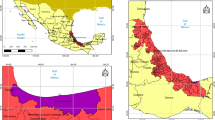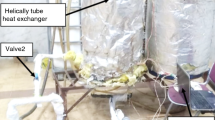Abstract
A quasi-steady model for the refrigeration system of an indoor ice rink was developed based on a combination of thermodynamic relations, heat transfer correlations and data available in the manufacturer’s catalogue. The system includes five compressors, rejects heat to the ambient air and uses R-22 to keep a stream of brine at a temperature of approximately −9°C. The model has been validated by comparison with measured values and with data from the manufacturer’s catalogue. It was then used to simulate its performance over a typical meteorological year. Results for a representative day include the number of compressors in operation at any given moment, their power consumption, the coefficient of performance (COP) of the cycle and of the system, as well as the heat rejected by the condensers and the corresponding mass flow rate of the cooling air. They show that the evaporation pressure is essentially constant while the condensation pressure varies from about 1600 to 2000 kPa. The COP of the system varies between 1.9 and 2.5. Results for the entire year show that the heat rejected during phase change is approximately four times that due to desuperheating and demonstrates the interest of recovering heat from both processes. Finally, the model is used to illustrate the advantages of a control strategy which limits the maximum number of simultaneously operating compressors to four. This strategy results in a 10% decrease of the energy used by the compressor motors and a 20% decrease of the peak power demand but increases the temperature of the brine at the exit from the chillers by approximately 0.5°C during short periods following the ice resurfacing operations.
Similar content being viewed by others
References
Bendapudi S, Braun JE (2002). A review of literature on dynamic models of vapor compression equipment. ASHRAE Report #4036-5.
Bourdouxhe JP, Grodent M, Lebrun JJ (1997). HVAC1 Toolkit: Algorithms and Subroutines for Primary HVAC System Energy Calculations. The American Society of Heating, Refrigerating and Air Conditioning Engineers.
Bourdouxhe JP, Grodent M, Lebrun JJ, Saavedra C, Silva KL (1994). A toolkit for primary HVAC system energy calculation-Part 2 Reciprocating chiller models. ASHRAE Transactions, 100(2): 774–786.
Cavallini A, Zecchin R (1974). A dimensionless correlation for heat and mass transfer in forced convection condensation. In: Proceedings of the 5th International Heat Transfer Conference, 309–313.
Cecchini C, Marchal D (1991). A simulation model of refrigerant and air-conditioning equipment based on experimental data. ASHRAE Transactions, 97(2): 388–393.
Daoud A, Galanis N (2006). Calculation of the thermal loads of an ice rink using zonal model and building energy simulation software. ASHRAE Transactions, 112(2): 526–537.
Daoud A, Galanis N, Bellache O (2008). Calculation of refrigeration loads by convection, radiation and condensation in ice rinks using a transient 3D zonal model. Applied Thermal Engineering, 28: 1782–1790.
ENERGYPLUS, http://www.eere.energy.gov/buildings/energyplus.
Fisher SK, Rice CK (1983). The Oak Ridge heat pump design models: 1. a steady-state computer design model for air-to-air heat pumps. Report No. ORNL/CON-80/R1., Oak Ridge, Tenn., Oak Ridge National Laboratory.
Gnielinski V (1976). New equations for heat and mass transfer in turbulent pipe and channel flow. International Chemical Engineering, 16: 359–368.
Jin H, Spitler JD (2002). A parameter estimation based model of water-to-water heat pumps for use in energy calculation programs. ASHRAE Transactions, 108(1): 3–17.
Kakaş S, Liu H (2002). Heat Exchangers Selection, Rating and Thermal Design, 2nd edn. Washington, DC: CRC Press.
Lavoie M, Sunyé R, Giguère D (2000). Potentiel d’économies d’énergie en réfrigération dans les arénas du Québec. Report prepared by the CANMET Energy Technology Center, Varennes, Quebec. (in French)
Nyers J, Stoyan G (1994). A dynamical model adequate for controlling the evaporator of a heat pump. International Journal of Refrigeration, 17 (2): 101–108.
Ouzzane M, Sunyé R, Zmeureanu R, Giguère D, Scott J, Bellache O (2006). Cooling load and environmental measurements in a Canadian indoor ice rink (RP-1289). ASHRAE Transactions, 112 (2): 538–545.
Petukhov BS (1970). Heat transfer and friction in turbulent pipe flow with variable physical properties. In: Advances in Heat Transfer, Vol 6. New York: Academic Press.
Popovic P, Shapiro HN (1995). A semi-empirical method for modeling a reciprocating compressor in refrigeration system. ASHRAE Transactions, 101(2): 367–382.
REFPROP (Reference Fluid Thermodynamic and Transport Properties Database): Version 8.0.
Sami SM, Dahmani A (1996). Numerical prediction of dynamic performance of vapor compression heat pump using new HFC alternatives to HCFC-22. Journal of Applied Thermal Engineering, 16: 691–705.
Seghouani L, Daoud A, Galanis N (2009). Prediction of yearly energy requirements of indoor ice rink. Energy and Buildings, 41(5): 500–511.
Shah MM (1982). Chart correlation for saturated boiling heat transfer: equation and further study. ASHRAE Transactions, 88(1): 185–196.
Sreedharan P, Haves P (2001). Comparison of chiller models for use in model-based fault detection. In: Proceedings of International Conference for Enhanced Building Operation, Austin TX (http://www.osti.gov/bridge/servlets/purl/829977-eNbJEo/native/829977.pdf).
Stefanuk NBM, Aplevich JD, Renksizbulut M (1992). Modeling and simulation of a superheat-controlled water-to-water heat pump. ASHRAE Transactions, 98(2): 172–184.
Svenssen MC (1999). Non-steady-state modelling of a water-to-water heat pump unit. In: Proceedings of the 20th International Congress of Refrigeration, Sydney, Paper No. 263.
Webb RL (1990). Airside heat transfer correlations for flat and wavy plate fin-and-tube geometries. ASHRAE Transactions, 96(2): 445–449.
Williatzen M, Pettit NBOL, Ploug-Sorensen L (1998). A general dynamic simulation model for evaporators and condensers in refrigeration. Part I: moving-boundary formulation of two-phase flows with heat exchange. International Journal of Refrigeration, 21(5): 398–403.
He XD, Liu S, Asada HH (1997). Modeling of vapor compression cycles for multivariable feedback control of HVAC systems. ASME Journal of Dynamic Systems, Measurement and Control, 119 (2): 181–191.
Xuejun S, Liu W, Que X, Chen Z (1999). Researches on dynamic simulation and optimization of automobile air-conditioning system, part 1: mathematical model and dynamic simulation of automobile air-conditioning system. In: Proceedings of the 20th International congress of refrigeration, Sydney, Paper No. 577.
Author information
Authors and Affiliations
Corresponding author
Rights and permissions
About this article
Cite this article
Seghouani, L., Galanis, N. Quasi-steady state model of an ice rink refrigeration system. Build. Simul. 2, 119–132 (2009). https://doi.org/10.1007/s12273-009-9209-x
Received:
Revised:
Accepted:
Published:
Issue Date:
DOI: https://doi.org/10.1007/s12273-009-9209-x




